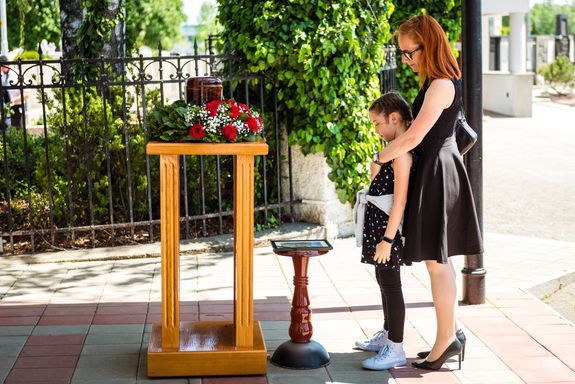What are the Different Types of Cremation Services Available?
More Americans than ever are opting for cremation. In 2000, only 27 percent of people chose it for their final disposition. In 2020, that number had doubled, and then some, to 56 percent. Projections developed by the Cremation Association of North America state that 80 percent of Americans will choose cremation by 2040.
For the large majority that prefers cremation, the disposition decision comes down to different types of cremation services. Those services include:
● Traditional cremation with a funeral service
● Cremation with a memorial service
There’s no right answer between the services above. Which one works the best for your family will depend on several factors.
What Does a Traditional Cremation Include?
What makes traditional cremation “traditional” is a funeral service held prior to cremation. It’s a familiar type of disposition that usually involves readings, eulogies, a viewing and some time for guests and family members to mourn together. This all takes place at a funeral home, and following the end of the funeral, the body is taken to a crematory for cremation. Following cremation, the cremated remains are placed in an urn and given to the family.
Because there’s a viewing and visitation involved, embalming the body is necessary prior to the ceremony. Additional cosmetic work may also be preferred before funeral services.
What Does a Cremation With a Memorial Service Include?
The cremation process does not require a funeral prior to disposition. If preferred, families may opt out of a traditional funeral and have the deceased’s remains cremated first.
Families that choose this option can have a separate memorial service that does not include the body, and therefore does not include a viewing. This is the primary difference between traditional cremation and cremation with a memorial service only. During a memorial service, people gather to remember their loved one as if it were a funeral, with readings and eulogies, but without a casket present.
With cremation, there’s no need to rush memorial arrangements, so many people prefer to wait until everyone can attend the service. This can be weeks, or even months after the decedent’s death.
What Does Direct Cremation Include?
Direct cremation is an emerging alternative to traditional cremation services. Direct cremation services are licensed to manage the cremation process, which starts with recovering the decedent’s remains at the place of death. The remains are taken directly to the funeral home or crematory and placed in refrigeration while the cremation service attains approval for cremation.
Once approval is granted, the decedent is cremated. The cremated remains are placed in a container and held for in person pickup or delivered to the family with mail or courier options.
The difference between direct cremation and other cremation services is that there is no memorial or funeral combined with cremation. Families can still opt for a memorial service at a later date, but it’s not required with direct cremation.
Traditional Cremation, Cremation With a Memorial, and Direct Cremation: A Summary
If you’re still having trouble determining which cremation service is right for you, here’s a quick summary of the most important points:
● Cost – Funeral costs have rapidly increased in recent decades, mostly due to the rise in casket costs. In the last 30 years, funeral expenses have increased at twice the rate of other goods and services. Caskets have risen in cost at an even faster rate. This, plus the use of a funeral home’s staff and facility, adds up to about $7,000, on average.
Cremation with a memorial service can be a couple of thousand dollars less if the memorial is handled directly through the cremation service.
Direct cremation is the least expensive option, averaging a bit more than $1,600. However, a basic direct cremation package may cost less than $1,000. It depends on what services and items, like an urn, are added to the cremation. And it depends on the service provider. Direct cremation will almost always cost more at a funeral home than a company that focuses exclusively on direct cremation.
● Planning process – The funeral planning process is a challenge during the best of times. You’ll need to contact a funeral home, contact family members, and send out notifications about date, time and place. If your loved one had any special requests for their funeral, you’ll need to work with the funeral home to make them happen. Because the decedent should be viewed as soon as possible, funerals must be held within a couple weeks of death.
If cremation will occur before a memorial, then there’s no need to rush the planning process. Some post-cremation memorials take place months after disposition.
● Other considerations – Funeral planning can be extremely complex if the decedent passed in another state. If the funeral is to take place in the decedent’s home state, you’ll need to work with a funeral home in both states to prepare and transport the body.
With direct cremation, the cremated remains can be mailed to any part of the continental U.S., which skips the added cost and complication of moving a body across state lines.
Also, if you’re planning a funeral with cremation, you’ll likely need to be present in-person to finalize the arrangements. This could also be a challenge if your loved one passes away far from home. With direct cremation, arrangements can be finalized online.
Cremation is Growing in Popularity, and Direct Cremation is a Cost-Effective Choice for Many Families
More than half of Americans have already decided on cremation for their final disposition. That trend is only growing, and within a couple of decades the vast majority of people will choose cremation instead of burial and other disposition options.
As the popularity of cremation grows, so does the number of available cremation services. One type, direct cremation, is a departure from traditional funeral and memorial services. It also offers several benefits to families who would rather put together their own memorial event.





